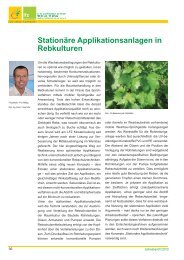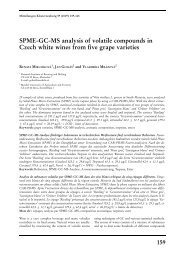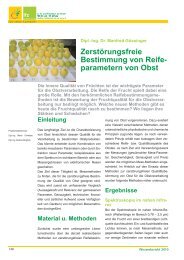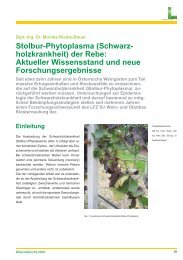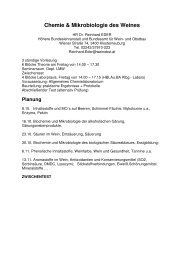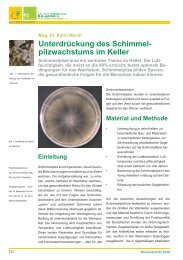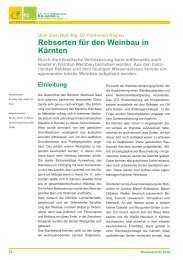General and polyphenolic composition of unripe grape juice (verjus ...
General and polyphenolic composition of unripe grape juice (verjus ...
General and polyphenolic composition of unripe grape juice (verjus ...
Create successful ePaper yourself
Turn your PDF publications into a flip-book with our unique Google optimized e-Paper software.
Mitteilungen Klosterneuburg 58 (2008): 28-31<br />
Pour Nikfardjam<br />
Table 1: <strong>General</strong> chemical <strong>composition</strong> <strong>of</strong> the <strong>verjus</strong> samples (n.d. = not detected)<br />
Material <strong>and</strong> Methods<br />
Verjus samples<br />
The <strong>verjus</strong> samples were bought from different stores<br />
<strong>and</strong> from our own winery.<br />
<strong>General</strong> chemical parameters<br />
The general chemical parameters <strong>of</strong> wine <strong>composition</strong>,<br />
such as sugar, alcohol etc., were analyzed according to<br />
the <strong>of</strong>ficial methods <strong>of</strong> wine analysis (Commission Regulation<br />
(EC) No1293/2005 <strong>of</strong> 5 August 2005 amending<br />
Regulation (EEC) No2676/90 determining Community<br />
methods for the analysis <strong>of</strong> wines)<br />
Polyphenol content was measured using the Folin method<br />
as published by RITTER (1997).<br />
Color<br />
Color <strong>of</strong> unfiltered samples was measured in 10 mm<br />
plastic cuvettes by means <strong>of</strong> a Spectronic 1001 spectrophotometer<br />
(Milton Roy Company, Dreieich, Germany)<br />
at 420, 520 <strong>and</strong> 620nm.<br />
Chemicals<br />
All reagents used were <strong>of</strong> analytical grade unless otherwise<br />
stated. HPLC water, acetonitrile (gradient grade),<br />
<strong>and</strong> phosphoric acid were from Merck (Darmstadt,<br />
Germany).<br />
Polyphenol st<strong>and</strong>ards<br />
Gallic acid, tyrosol, catechin, epicatechin, procyanidin<br />
B 2 , p-coumaric acid, caffeic acid, ferulic acid, quercetin-3-rutinosid<br />
(rutin), trans-resveratrol, <strong>and</strong> quercetin<br />
were from Extrasynthese (Genay, France). Hydroxycinnamic<br />
acid esters were calculated as their respective<br />
free acids: caftaric acid, p-coutaric acid, fertaric acid,<br />
p-coumaroyl-glucosyl-tartrate (p-CGT), <strong>and</strong> Grape<br />
Reaction Product (GRP, 2-S-glutathionyl caffeoyl tartaric<br />
acid). Hydroxycinnamic acid esters were identified<br />
by their photodiode array (PDA) spectra <strong>and</strong> retention<br />
time.<br />
Equipment<br />
A Dionex (Germering, Germany) UltiMate 3,000<br />
HPLC system consisting <strong>of</strong> degasser, autosampler,<br />
pump, column oven, <strong>and</strong> photodiode array (PDA) detector<br />
was used. Best selectivity by means <strong>of</strong> a PDA detector<br />
was achieved at 280nm for benzoic acids; at<br />
310nm for trans-resveratrol; at 320nm for hydroxycinnamic<br />
acids <strong>and</strong> their respective esters <strong>and</strong> GRP; <strong>and</strong><br />
at 360nm for flavonols.<br />
HPLC method<br />
Separation <strong>of</strong> the <strong>polyphenolic</strong>s was performed using<br />
the method published by RECHNER et al. (1998).<br />
Sample preparation<br />
Before analysis by HPLC, all samples <strong>and</strong> st<strong>and</strong>ards<br />
were filtered through a Sartorius (GoÈ ttingen, Germany)<br />
Minisart RC 15 1 0.45mm filter. A volume <strong>of</strong> 20ml was<br />
injected.<br />
29



